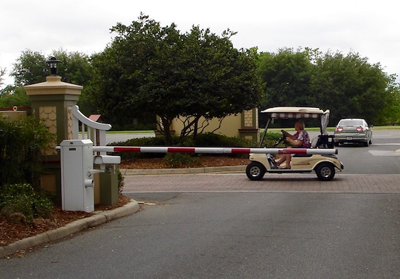Are You Ready for Autonomous Technology?
Certainly, one of the fun times in our little community with the gates is the annual “parade of golf car pride” in which the many owners of golf cars—otherwise known as personal transportation vehicles or PTVs—strut their latest upgrades, accessories, decals, paint, and upholstery. A little competitive vanity never hurt anyone.
By and large, the residents of gated communities are able-bodied, active adults fully capable of driving their on-road vehicles as well as their PTVs. A certain number of residents, however, may be incapacitated to the degree that they must depend on others for getting from point A to point B. Others, disabled in one way or another, who may be looking for retirement living, eliminate gated communities from consideration because the homes tend to be spread out and at a distance from stores and other amenities.
Potential of self-driving, autonomous vehicles
New technologies will allow gated communities to become more handicapped friendly and more attractive to a wider set of buyers. So, what are these new technologies? There are several possibilities—let’s focus on two, in particular, autonomous shuttles and PTVs:
- Shuttles are ride-share facilities and in autonomous mode accommodate multiple passengers in a predetermined, timed route;
- An autonomous PTV, on the other hand, can be hailed by individual and is dedicated to whatever destination the ride-hailer wants.
- “Autonomous” essentially means that the vehicles in question does not need human intervention to implement the service provided—that service being mobility from point A to point B. Of course, the timing and direction of that mobility is fully put in motion by human preferences.
Innovators in the self-driving services
Self-driving vehicles of the type mentioned are not blue-sky concepts, to be implemented, perhaps, in the distant future. No, companies offering self-driving services are already doing business.
One example is the California based company, Ridecell, that is developing self-driving, low-speed vehicles for use on private property such as colleges, theme parks, business parks, retirement communities, and basically any campus-like setting that can set its own traffic rules. Ridecell recently acquired autonomous shuttle system provider, Auro Robotics. Auro implemented a highly successful demonstration project of its autonomous shuttle system on the campus of Santa Clara University in California.
Self-driving shuttles on college campuses
Auro’s battery-electric shuttle has a top speed of 25 mph and a 90-mile range. Auro currently builds three different configurations to suit various transportation needs and is using Polaris GEM vehicles as their base vehicle platform. They provide 2, 6 or 12 seat shuttles depending on customer need. In the development of an overall fleet system, Ridecell will be providing fleet-management software and services, which they already supply to BMW’s and Volkswagen’s car sharing services.
College campuses in particular are already a major market for GEM. Development of the manufacturer, technology provider, and dealer relationships is yet to be fully worked out, but will be coming as the market expands. It is likely that Ridecell, Polaris corporate, and local GEM dealers will partner in the production and marketing self-driving vehicles and systems.
From the college campus to the gated community
A Ridecell/Auro-type product would more likely be marketed to the organization operating the community rather than individual owners since it would be a shuttle service shared by the community. Ridecell/Auro have the technology and GEM has the appropriate product at the moment, so do not be surprised if a marketing team touting the system shows up and presents at your next community forum.
From shuttles to ride-hail PTVs
What about ride-hailing services using self-driving vehicles? By this time, everyone has heard of Uber and Lyft. Both companies are working feverishly at on autonomous systems. Garia, maker of those elegant golf cars, is market-testing a line of self-driving utility vehicles in London, as part of a potential on-call, small-package delivery system. So, the concept of on-call services, catering to individual needs and using self-driving technology, is well on its way.
The real question is, how such a system would be received in your typical gated community? After all, we love our little gems. Not only are they beautiful (as in the eye of the beholder), but they offer countless talking points with neighbors and friends.
So, does it come down to: Conformity and utility vs. self-expression and personality? My guess is that both preferences will fit nicely in the context of the gated community and complement each other, rather than compete.
Contact the Author: Steve Metzger at smetzger@smallvehicleresource.com. Or check out our website at www.smallvehicleresource.com, where you will find an extensive database of vehicle models and can make side-by-side comparisons of vehicles based on a full set of specifications.



